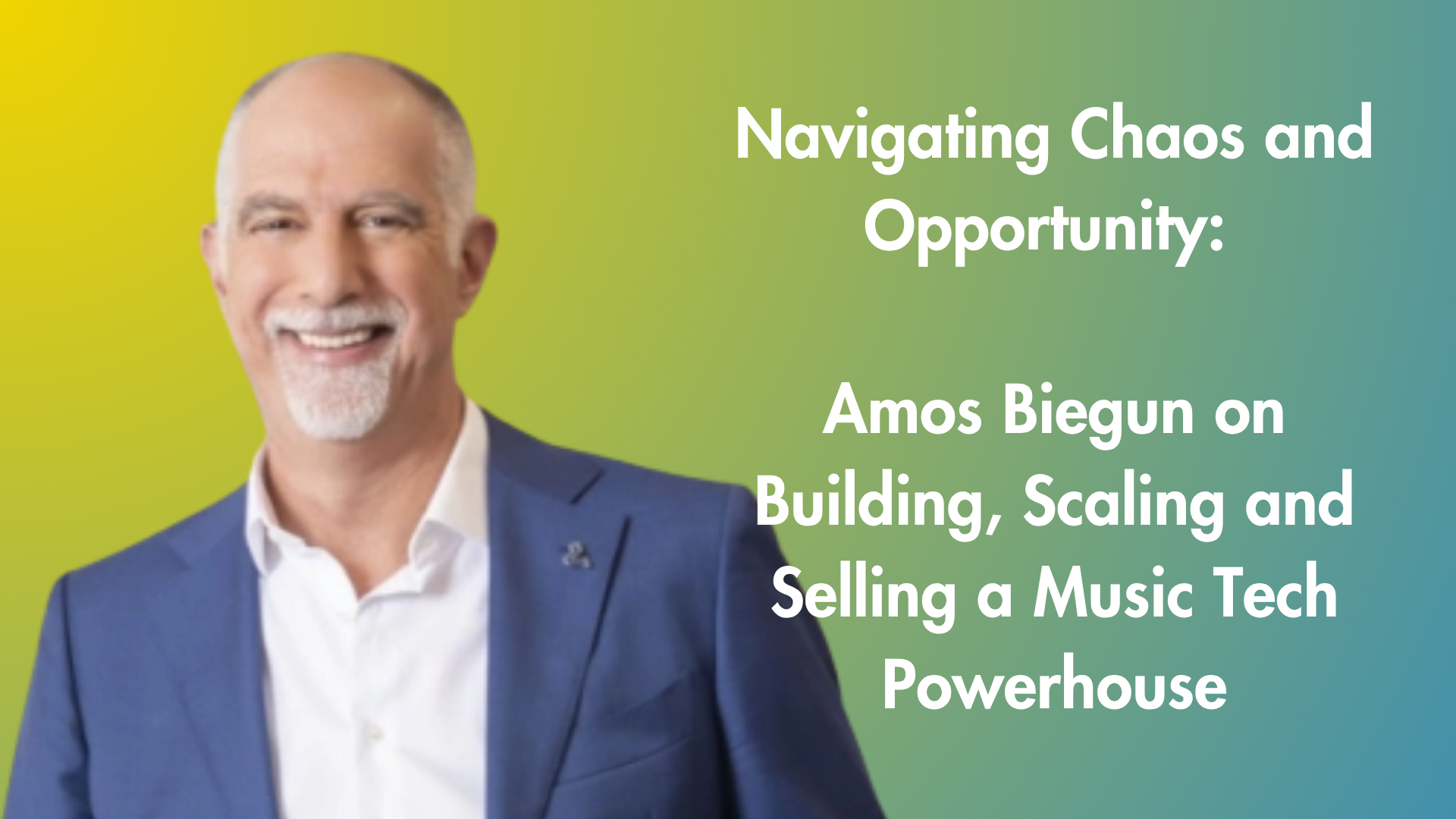In a candid fireside chat with MTUK Chair Cliff Fluet, Vistex CEO Amos Biegun reflected on his extraordinary 30-year career as a trailblazer in music technology success. Here we summarise Amos’s key insights.
Early Realisations: The Industry’s Disconnected Chaos
Biegun’s entry into the music technology sector was marked by a realisation: the industry was a patchwork of disconnected players and systems, barely managing to keep up with the increasing volume and complexity of rights and royalties. In the early days, even the simple act of transferring files between companies was fraught with technical incompatibilities and inefficiencies. This chaos, however, was not just a problem – it was an opportunity.
He saw that the industry’s lack of integration and standardisation created a fertile ground for innovation. The challenge was not just to build a better system, but to create a backbone for the industry – a robust, scalable platform that could handle the intricacies of rights and royalties across music, film, TV, and beyond.
Staying True to Core Competence: Rights and Royalties
As Biegun and his team at Counterpoint set out to build their business, they faced the perennial temptation to diversify and chase every new trend. The key to their success, he insists, was an unwavering focus on their core expertise: rights and royalties. While others were distracted by the latest fads, Counterpoint doubled down on building the best possible back-office systems for rights management.
This focus did not mean stagnation. Instead, it became the foundation for strategic expansion. Counterpoint took its core principles and applied them to adjacent industries – first music publishing, then record labels, and eventually film, TV, and merchandise licensing. Each move was carefully considered, leveraging existing expertise while adapting to the nuances of each sector.
Scaling Up: Organic Growth and Strategic Acquisitions
Scaling a niche product into a market leader required both organic growth and strategic acquisitions. Biegun describes how Counterpoint partnered with key clients, such as Pathé Films, to co-develop solutions tailored to their needs. These partnerships were structured to align incentives: clients would fund development in exchange for royalties from future sales, ensuring both parties were invested in the product’s success.
As Counterpoint gained traction, it expanded into new verticals through acquisition. The purchase of a leading merchandise and brand licensing software company in Northern California brought new capabilities and synergies, allowing Counterpoint to cross-sell to major studios like MGM and 20th Century Fox. The lesson was clear: stay true to your core, but don’t be afraid to acquire expertise and customer bases that complement your strengths.
Surviving Disruption: The Dotcom Crash and Industry Turbulence
The late 1990s and early 2000s were a period of unprecedented change. The rise of the internet, the dotcom bubble, and the subsequent crash created both opportunities and existential threats. Biegun recounts how Counterpoint resisted the urge to go all-in on the dotcom hype, instead taking a cautious, measured approach. When the bubble burst, many competitors who had bet everything on the web disappeared. Counterpoint survived, but not unscathed – the crash led to a widespread aversion to software investment, and the music industry itself was contracting under the twin pressures of piracy and declining physical sales.
Resilience and focus were essential. Biegun emphasises the importance of insulating oneself from the noise and hype, staying true to core beliefs even when the world seems to be moving in a different direction. Knowing when to pivot is important, but so is the discipline to avoid being swept up in every new trend.
Leadership in Crisis: Lessons from Near-Death Experiences
Every successful business faces moments of existential crisis. For Counterpoint, the dotcom crash was a near-death experience. Revenues dried up, and the company was forced to make painful cuts – reducing the workforce by 30% over three rounds. The lesson, Biegun says, is to act decisively: if cuts are necessary, make them hard, deep, and fast. Prolonging the pain helps no one.
Survival required both financial acumen and strong relationships. Counterpoint turned to its bankers and top customers, explaining the situation honestly and securing the support needed to weather the storm. By 2002, the company was growing again, having learned the value of transparency, trust, and decisive action.
The Art and Agony of Mergers and Acquisitions
For many founders, the dream is to buy, merge, or sell a business. Biegun has been on all sides of the table, and his insights into the M&A process are both practical and deeply human.
Valuation, he notes, is as much art as science—especially for early-stage companies. The key is to understand what you are trying to achieve: is it a quick exit, or long-term growth? When acquiring, it’s vital to look beyond revenue and customers. The real value often lies in people and know-how. Attempting to simply merge customer bases and cut costs rarely works as planned; customers resist being forced onto new systems, and the anticipated synergies often fail to materialise.
When selling, the process is gruelling. The seller is under the spotlight for months, balancing the demands of due diligence with the need to keep the business running smoothly. Biegun advises involving key team members early, maintaining business performance throughout the process, and being honest about the likely outcomes for staff. The emotional toll is significant—relief often outweighs happiness when the deal finally closes.
Integration and the Human Factor
Post-acquisition integration is where many deals falter. Biegun stresses the importance of preserving the entrepreneurial spirit within a larger corporate structure. When Counterpoint was acquired by Vistex, he negotiated a direct reporting line to the CEO, ensuring visibility and continuity for the new division. The goal was not just to absorb Counterpoint, but to leverage its expertise to build a new market segment within Vistex.
The human side of integration is critical. Founders and key staff may not always fit within the new organisation, and difficult conversations are sometimes necessary. Biegun admits that, in hindsight, he should have addressed these issues earlier in the integration process, as delayed action can be disruptive and costly.
Leadership Through Tragedy: Stepping Up at Vistex
Perhaps the most profound test of Biegun’s leadership came in 2024, when Vistex’s founder and CEO, Sanjay Shah, and its president, Raju Datla, died in a tragic accident. Suddenly, the company lost its top two leaders, and Biegun was asked to step in as interim, then permanent, CEO.
His approach was to return to basics: convene the senior leadership team, stabilise the business, and focus on three priorities – customer continuity, staff reassurance, and maintaining strategic partnerships (notably with SAP). The experience reinforced the importance of team, communication, and a clear sense of purpose. Honouring the legacy of the founders while forging a new path required both respect for the past and a willingness to embrace change.
The Power and Peril of Data
Throughout his career, Biegun has been a passionate advocate for the strategic value of data. The music industry, he argues, remains mired in fragmented, inconsistent data sets, leading to inefficiency, ambiguity, and lost revenue. The solution is not just technological, but cultural: the industry must embrace data consolidation, whether through physical or virtual means.
He draws a compelling analogy to the global banking system: if a Visa card can access funds in real time from an ATM in the Sahara, why can’t the music industry achieve real-time rights and royalty accounting? The answer lies in the industry’s reluctance to share and standardise data, a problem that will only grow as the volume and complexity of transactions increases.
Frontier Technologies: AI and Blockchain
Looking to the future, Biegun sees enormous potential in frontier technologies like AI and blockchain. While blockchain has yet to deliver on its promise in the music industry – largely due to data quality issues – AI is already proving to be a powerful enabler of data consolidation and insight.
AI can automate the ingestion, mapping, and analysis of complex, fragmented data sets, making it possible to identify synergies, optimise licensing, and deliver real-time analytics. For smaller players, AI offers a way to compete with the data-rich giants, enabling virtual consolidation and collaborative licensing models. The key, Biegun believes, is to focus on practical applications that deliver immediate value, rather than chasing hype for its own sake.
Advice for Founders: Be Brave, Build Teams, and Stay Focused
Asked for the best advice he’s received, Biegun credits his mentor, Bob Katovski, with two enduring lessons: be brave, and build a strong team. Growth requires risk-taking and the courage to act decisively, even in the face of uncertainty. But no individual can scale a business alone – the quality of the team is paramount.
He also emphasises the importance of resilience and focus. The temptation to chase every new opportunity is strong, especially in times of hype and disruption. But true success comes from staying true to your core, insulating yourself from the noise, and knowing when to pivot and when to hold firm.
Conclusion: Legacy, Leadership, and the Future
Amos Biegun’s insights into the trials of growth, the agony and ecstasy of exits, and the enduring importance of data and team offer a roadmap for founders and leaders in any industry.
As the music and entertainment sectors continue to evolve, the challenges of data fragmentation, technological disruption, and human integration remain as pressing as ever. Amid chaos and change, opportunity awaits those who are brave enough to seize it, focused enough to pursue it, and wise enough to build the teams that will make it a reality.

